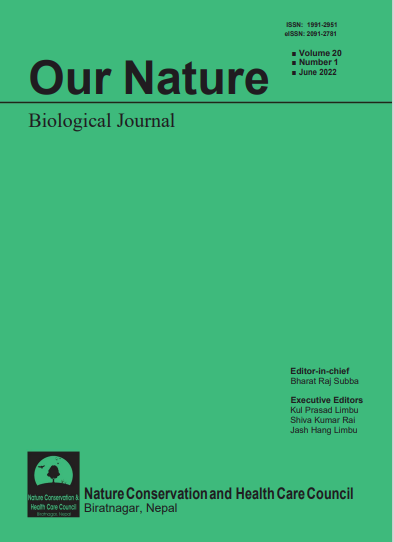Fish species composition, distribution and community structure in the Pathariya River of Kailali, Farwestern, Nepal
DOI:
https://doi.org/10.3126/on.v20i1.45207Keywords:
Diversity, fish habitat, freshwater, Himalaya, fish ecologyAbstract
This study examined the status of fish resources in the Pathariya River, from September 2017 to August 2018 covering four seasons- Autumn (September, October, and November), Winter (December, January, and February), Spring (March, April, and May) and summer (June, July, and August). We used a cast net of 1.5 cm to 2.5 cm and a Gill net having 2-3 cm mesh size, 30-35 feet long and 3-4 feet width, with the help of a local fisherman. A total of 407 individuals belonging to 4 orders, 8 families, 16 genera, and 25 species were collected from Malbhanga, Thakurwdara, Sonalipur, and Dhunganatol of Pathariya River. The majority of the fishes belonged to the family Cyprinidae (53.56%) followed by Bagridae (17.44%), Mastacembelidae (11.31%), Channidae (8.11%), Cobitidae (5.65%), Claridae (1.72%), Nandidae (1.47%), and Siluridae (0.74%). The most abundant species were Puntius ticto, Puntius sophore, and Mystus tengra. The one-way analysis of variance on Canonical correspondence analysis (CCA) confirmed that dissolved oxygen, free carbon dioxide, and total hardness were the influencing factors (P<0.05) in shaping the fish community structure. The difference in fish assemblage structure and diversity in the Pathariya river are probably related to habitat type, altitude, season, several environmental factors, and anthropogenic activities.
Downloads
Downloads
Published
How to Cite
Issue
Section
License
Copyright (c) 2022 Netra Neupane, Dipak Rajbanshi

This work is licensed under a Creative Commons Attribution-NonCommercial 4.0 International License.
This license enables reusers to distribute, remix, adapt, and build upon the material in any medium or format for noncommercial purposes only, and only so long as attribution is given to the creator.




